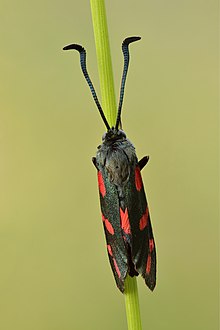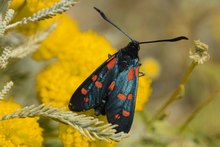Six-spot burnet
| Six-spot burnet moth | |
|---|---|

| |
| Adult of Zygaena filipendulae | |
| Scientific classification | |
| Domain: | Eukaryota |
| Kingdom: | Animalia |
| Phylum: | Arthropoda |
| Class: | Insecta |
| Order: | Lepidoptera |
| Family: | Zygaenidae |
| Genus: | Zygaena |
| Species: | Z. filipendulae
|
| Binomial name | |
| Zygaena filipendulae | |
| Synonyms | |
| |

The six-spot burnet (Zygaena filipendulae) is a day-flying moth of the family Zygaenidae.
Subspecies



- Z. f. altapyrenaica Le Charles, 1950
- Z. f. arctica Schneider, 1880
- Z. f. balcanirosea Holik, 1943
- Z. f. campaniae Rebel, 1901
- Z. f. duponcheli Verity, 1921
- Z. f. filipendulae
- Z. f. gemella Marten, 1956
- Z. f. gemina Burgeff, 1914
- Z. f. gigantea Rocci, 1913
- Z. f. himmighofeni Burgeff, 1926
- Z. f. liguris Rocci, 1925
- Z. f. maior Esper, 1794
- Z. f. mannii Herrich-Schaffer, 1852
- Z. f. noacki Reiss, 1962
- Z. f. oberthueriana Burgeff, 1926
- Z. f. polygalae (Esper, 1783)
- Z. f. praeochsenheimeri Verity, 1939
- Z. f. pulcherrima Verity, 1921
- Z. f. pulcherrimastoechadis Verity, 1921
- Z. f. pyrenes Verity, 1921
- Z. f. seeboldi Oberthur, 1910
- Z. f. siciliensis Verity, 1917
- Z. f. stephensi Dupont, 1900
- Z. f. stoechadis (Borkhausen, 1793)
- Z. f. zarana Burgeff, 1926
Distribution
Zygaena filipendulae is a common species throughout Europe, except the Atlantic coast of the Iberian Peninsula, northern Scandinavia and the Great Russian North. It is also present in Asia, from Anatolia through the Caucasus to Syria and Lebanon.[1]
Habitat
This species can be found in meadows, woodland clearings, sea-cliffs and area rich in grasses and flowers, up to 2,000 m altitude.[2]
Description
Zygaena filipendulae has a
It is an aposematic moth because it is distinguished by its colors as toxic to predators like birds and lizards. If attacked it emits a liquid containing cyanide.
Biology
The adults fly on hot, sunny days from June to August,[Note 1] and are attracted to a wide variety of flowers such as knapweed and scabious, as well as the larval food plants bird's foot trefoil, Coronilla and clover.[3]
The species overwinters as a larva. The larva
Lifecycle
-
Eggs
-
Caterpillar
-
Cocoon
-
Pupa (cocoon removed)
-
Adult
Bibliography
- C. M. Naumann, G. M. Tarmann, W. G. Tremewan: The Western Palaearctic Zygaenidae. Apollo Books, Stenstrup, 1999, ISBN 87-88757-15-3
- Capinera, J. L. (Ed.), Encyclopedia of Entomology, 4 voll., 2nd Ed., Dordrecht, Springer Science+Business Media B.V., 2008, pp. lxiii + 4346, ISBN 978-1-4020-6242-1
- Chinery, Michael. Collins Guide to the Insects of Britain and Western Europe 1986. (reprinted 1991).
- Kükenthal, W. (Ed.), Handbuch der Zoologie / Handbook of Zoology, Band 4: Arthropoda - 2. Hälfte: Insecta - Lepidoptera, moths and butterflies, in Kristensen, N. P. , Handbuch der Zoologie, Fischer, M. (Scientific Editor), Teilband/Part 35: Vol. 1: Evolution, systematics, and biogeography, Berlino, New York, Walter de Gruyter, 1999 [1998], pp. x + 491, ISBN 978-3-11-015704-8
- Scoble, M. J., The Lepidoptera: Form, Function and Diversity, seconda edizione, London, Oxford University Press & Natural History Museum, 2011 [1992], pp. xi, 404, ISBN 978-0-19-854952-9
- Skinner, Bernard.Colour Identification Guide to Moths of the British Isles 1984.
- Stehr, F. W. (Ed.), Immature Insects, 2 volumi, seconda edizione, Dubuque, Iowa, Kendall/Hunt Pub. Co., 1991 [1987], pp. ix, 754, ISBN 978-0-8403-3702-3
Notes
- ^ The flight season refers to the British Isles. This may vary in other parts of the range.
References
- ^ Fauna Europaea
- ^ UK Moths
- ^ Paolo Mazzei, Daniel Morel, Raniero Panfili Moths and Butterflies of Europe and North Africa
- ^ First Nature
External links
- Funet Taxonomy
- Lepiforum.de
- Lepinet.fr





